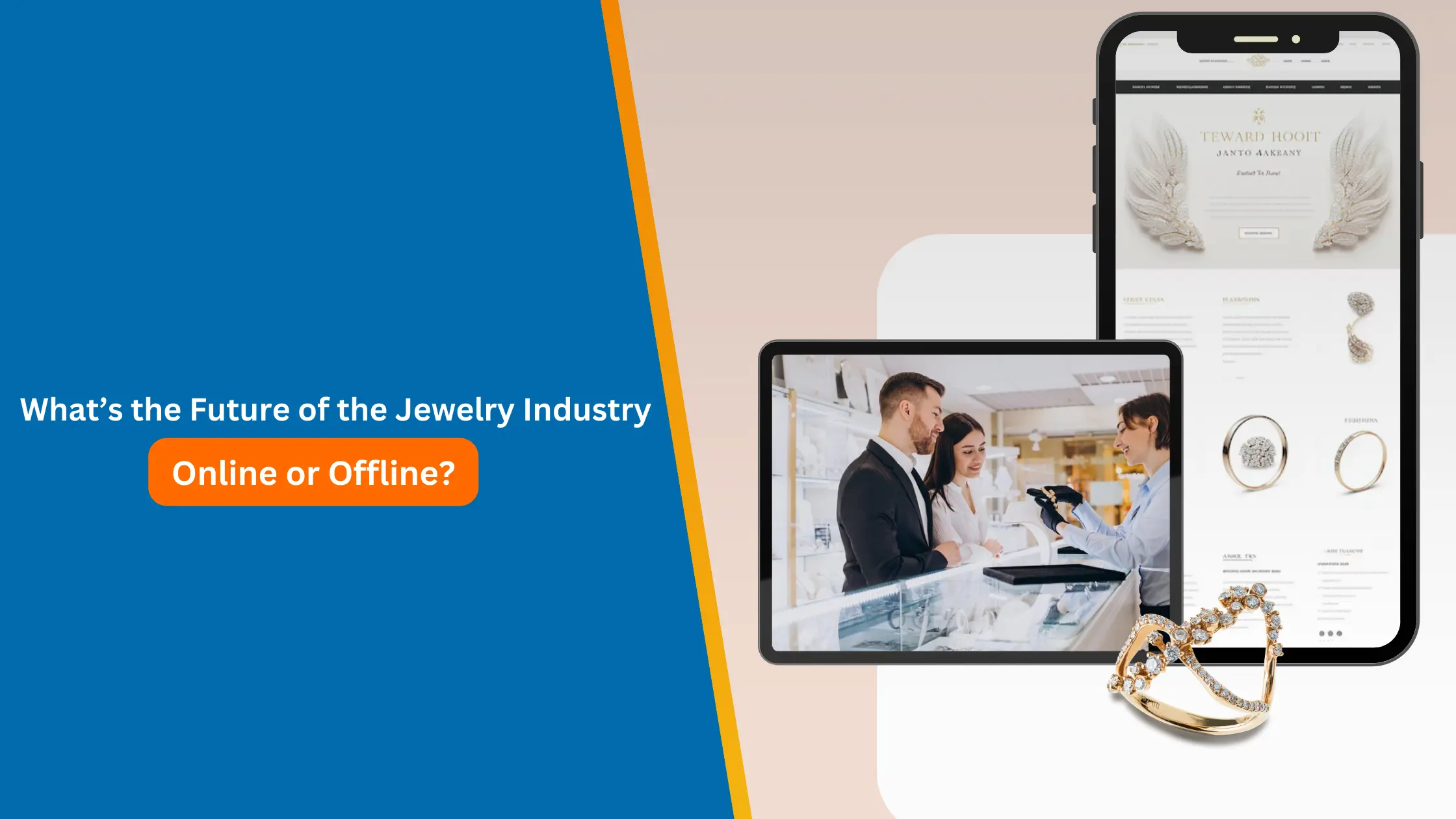Are you wondering about the future of the jewelry industry, whether opening a traditional brick-and-mortar store is a sustainable option or launching a new digital store would be a safe option? This is a common question that arises for any entrepreneur, particularly a jewelry enthusiast, as both digital and physical channels come with their own challenges.
According to a poll conducted in 2023 of 2000 people, 62% of the respondents purchased at least their jewelry pieces through the web. Only 28% of them purchased jewelry through physical stores, and the rest 10% of them bought from physical stores but found them through the web.
So, there are many possibilities, it is just how you shape a possibility to work in your favor. Opening a traditional jewelry outlet always involves investment and carries a risk of profitability. Similarly, a digital storefront is surrounded by speculation. Does it have optimal exposure to boost organic traffic and conversions?

See How Our Experts Can Drive More Traffic to Your Website!
SEO: Boost your rankings and drive more organic traffic today!
Website Design/Development: Create a stunning website that converts visitors into customers.
Paid Media: Reach the right audience at the right time with expertly managed paid media.
So, it is common to wonder about the future of the jewelry industry, and as a professional jewelry website development company, we can help you figure out what the future holds for the jewelry industry.
How the Jewelry Industry is Changing?
The evolving and changing trends in the jewelry industry make it dynamic. Traditional jewelers with physical outlets have established their digital presence, and online brands are trying to launch their offline merchandise outlets. According to Forrester, 70% of US retail sales will be digitally influenced, like digital experiences will drive the conversion rates.
Customers now prefer browsing for items online which makes it vital for traditional jewelry stores to establish an online presence. However, simply being online is not enough. Your jewelry website must have an interactive and engaging interface to retain visitors and encourage purchases.
Similarly, online established brands are opting to open their brick-and-mortar stores due to low conversion rates and profitability. Physical stores have >50% conversion rates as compared to precious jewelry online stores, which have >1%.
It is obvious that consumers do not feel secure purchasing big-ticket items online, and they suspect the quality because they cannot feel and touch the jewelry pieces. Hence, the online brands are expanding their businesses to the offline front.
So, what does the future of the jewelry industry hold? Well, the answer is omnichannel presence.
Omnichannel Presence: The Future of the Jewelry Industry
The jewelry industry is changing faster than ever, and the key to staying ahead is meeting customers wherever they are. Whether it’s online, in-store, or even on their phones, an omnichannel approach helps jewelers create a seamless experience that matches today’s shopping habits.
What Does Omnichannel Mean for Jewelry?
Omnichannel is about connecting the dots between every way customers shop. Imagine someone scrolling through Instagram, spotting a stunning necklace, and trying it on virtually through an app. Later, they visit the store to see it in person, or maybe they complete the purchase online after a few days of thinking.
This isn’t just a trend, in fact, it’s how people shop now. Jewelers who can blend their physical stores with their digital platforms are setting themselves up for long-term success.
Why Omnichannel Matters
- Customers Want Options: Shoppers no longer stick to one way of buying. Some prefer browsing in a store, while others like the convenience of online shopping. An omnichannel approach gives them the freedom to choose what works for them.
- Trust is Built In-Store, Convenience Online: Jewelry is indeed a big investment, and many customers want to see and feel the piece before they buy. But they also love the convenience of comparing options and shopping online. Bringing both together builds trust and keeps customers happy.
- Better Insights Mean Better Service: You can learn more about what your customers want by connecting your online and offline platforms. You can precisely understand their favorite designs, price ranges, or shopping preferences. It eventually helps you offer them exactly what they’re looking for.
What Makes an Omnichannel Strategy Work?
- Consistency Everywhere: Your customers should see the same information, whether they’re in-store or online. If they check for a necklace on your website, they should be able to find it in the store without any confusion.
- Technology That Makes Shopping Fun: Tools like virtual try-ons, easy checkout options, and mobile-friendly websites make the online experience feel just as special as visiting a store.
- Personalized Touch: Customers love when brands remember them. Whether it’s a follow-up email after a store visit or personalized recommendations on your website, small touches can make a big difference.
A Real-World Advantage
Some jewelry brands are already excelling with an omnichannel presence. They have seen higher sales, more loyal customers, and fewer missed opportunities by connecting their online and offline efforts. It’s proof that when you make shopping easier for your customers, they come back for more.
The Future of Jewelry is Both Online and Offline
Jewelry shopping is personal, and that won’t change. People will always value the experience of walking into a store, feeling the weight of a ring, or seeing a diamond sparkle under the light. But they also want the convenience of shopping from their couch or discovering new designs on social media.
Jewelers can create a shopping experience that’s as timeless as their pieces by combining the best of both worlds.
Future Trends Shaping the Jewelry Industry
As consumer preferences evolve and technology advances, the age-old art of jewelry-making embraces remarkable changes. Let’s explore how these powerful forces are reshaping this timeless industry:
- Sustainability: The industry is witnessing a fundamental shift toward eco-conscious practices. Consumers actively seek pieces that reflect both luxury and environmental values. Leading jewelry brands now emphasize transparent sourcing and sustainable materials. Moreover, jewelry is used in recycled materials in its collections. Many brands also now highlight their environmental commitments through digital platforms.
- Technological Integration: Future of White label web development focuses on immersive experiences. Augmented reality helps customers virtually try on jewelry pieces. Virtual showcases create engaging online shopping environments for customers. Advanced technology bridges the gap between digital and physical retail. These innovations help jewelry brands stay competitive in evolving markets.
- Personalization: Data-driven personalization creates unique shopping experiences for each customer. Smart algorithms recommend products based on individual browsing patterns. Jewelry websites also now offer customized product suggestions and content. Besides them, many brands use AI to enhance customer engagement strategies.
- Role of NFTs: Digital authentication through NFTs ensures jewelry piece authenticity. For example, blockchain technology provides transparent tracking of jewelry sourcing. NFTs create unique digital identities for luxury jewelry items. This technology builds trust and verification in online transactions.
Wrapping Up
The future success of jewelry retail depends on balanced strategies. Brands must invest in both digital presence and physical stores. Also, they should focus on creating a seamless experience across all channels. Physical stores will continue offering irreplaceable tactile experience and guidance. Online platforms will enhance these experiences with advanced digital tools.
Using professional web development promises smooth online shopping experiences. Strong SEO strategies help jewelry businesses reach target audiences. Smart and strategic implementation of these solutions helps jewelry businesses adapt to changing market demands. Moreover, this balanced approach helps build lasting connections with modern customers. So, the combination of technology and tradition creates winning retail models.






